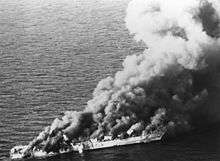Iranian frigate Sahand
_1977.jpg) A starboard bow view of the Iranian destroyer escort ITS Faramarz (DE 74), redesignated as IRS Sahand (F 74) | |
| History | |
|---|---|
| Name: | IIS Faramarz |
| Namesake: | Faramarz |
| Ordered: | 1960 |
| Builder: | Vosper Thornycroft, Woolston[1] |
| Yard number: | 1080[1] |
| Launched: | 30 July 1969[1] |
| Commissioned: | February 1972[1] |
| Renamed: | Sahand, 1985[1] |
| Namesake: | Sahand volcano |
| Homeport: | Bandar-Abbas |
| Fate: | sunk in Operation Praying Mantis, 19 April 1988[1] |
| General characteristics | |
| Class and type: | Alvand-class frigate |
| Displacement: | 1,100 tons (1,540 tons full load) |
| Length: | 94.5 m (310 ft) |
| Beam: | 11.07 m (36.3 ft) |
| Draught: | 3.25 m (10.7 ft) |
| Propulsion: |
|
| Speed: | 39 knots (72 km/h) max |
| Range: | 5,000 nmi (9,000 km) at 15 knots (28 km/h) |
| Complement: | 125-146 |
| Armament: |
|
Iranian frigate Sahand (in Persian سهند), a British-made Vosper Mark V class frigate (also known as the Alvand class), was commissioned as part of a four-ship order. The ship was originally called Faramarz, named after a character in Ferdosi's Shahnameh. However after the 1979 Islamic Revolution, it was renamed Sahand, after the Sahand volcano.
Service history

The Iranian Navy ship was sunk in Operation Praying Mantis on 18 April 1988. Located by two American A-6E Intruders of Attack Squadron VA-95 steaming roughly 16 kilometres (10 mi) southwest of Larak Island, she was hit by two Harpoon missiles and two AGM-123 Skipper II laser-guided missiles. A pair of Rockeye cluster bombs from the aircraft and a single Harpoon from the destroyer USS Joseph Strauss finished off the ship. Left heavily aflame, dead in the water and listing to port, Sahand burned for several hours before fire reached her ammunition magazines and they detonated, sinking the ship in over 660 feet (200 metres) of water southwest of Larak Island.
Iran is building a Moudge-class frigate named Sahand in memory of the original Sahand.
Notes
References
- Hiro, Dilip (1991). The Longest War: The Iran-Iraq Military Conflict. London: Routledge Chapman & Hall, Inc. ISBN 0-415-90406-4.
